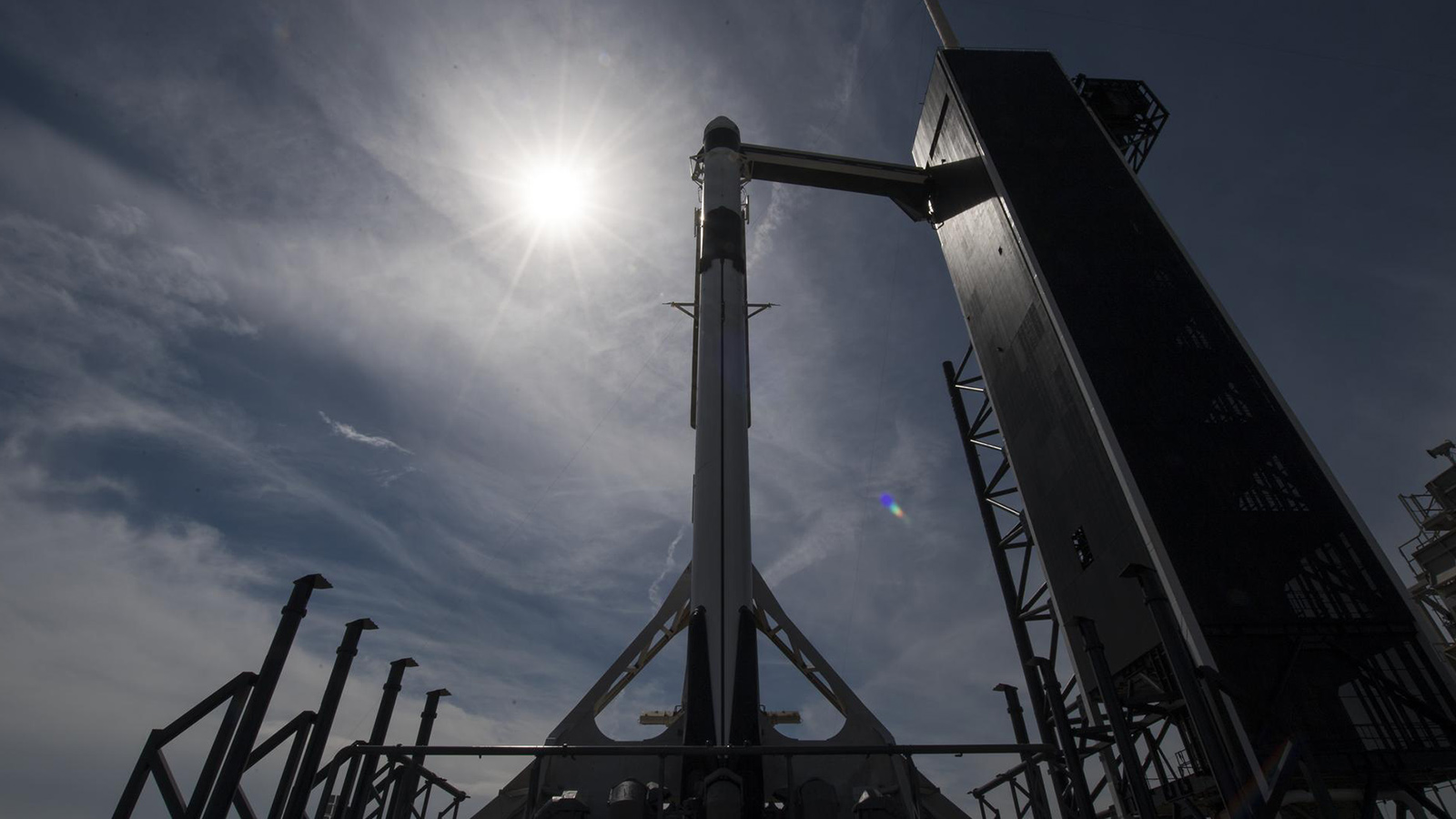Stay Up to Date
Submit your email address to receive the latest industry and Aerospace America news.
NASA wants Commercial Crew up and flying this year
UPDATE: SpaceX and NASA teams recovered the Crew Dragon capsule from the Atlantic Ocean following the in-flight abort test, which was pushed back to Sunday, Jan. 19, because of weather conditions. NASA Administrator Jim Bridenstine dubbed the test “successful” in a tweet.
Residents and space watchers on the Florida coast may see a SpaceX Falcon 9 rocket breaking apart over the Atlantic Ocean on Saturday morning, but it’s no accident.
The destruction will occur during the final test that the SpaceX Crew Dragon must pass before NASA permits the capsules to ferry astronauts to the International Space Station. In this uncrewed test, Crew Dragon’s engines and thrusters will propel the capsule away from a Falcon 9 rocket, as if there were a crew inside who needed to be saved from an exploding or fizzling launch vehicle. As the capsule comes in for a gentle parachute landing in the Atlantic Ocean, the rocket will become unstable and break apart over the ocean.
Crew Dragon must prove its launch abort system before it can fly crew and help end U.S. reliance on the Russian Soyuz spacecraft that have been NASA’s only transportation to the ISS since 2011. The agency originally said its Commercial Crew contractors Boeing and SpaceX would be flying crew by the end of 2017, but as of early 2020 neither had done so.
NASA now says those crewed flights will occur in the “first part” of 2020, a goal that NASA Administrator Jim Bridenstine has called the agency’s “highest priority.” Nevertheless, he stressed to attendees of a Capitol Hill luncheon last month that crew safety comes before the schedule.
“We’re not going to do anything that will bring undue danger to our astronauts, but we have to launch our astronauts,” Bridenstine said.
Here’s the sequence of events for the Jan. 18 in-flight abort test, or IFA:
A Crew Dragon capsule with two test dummies will blast off from Launch Pad 39A at NASA’s Kennedy Space Center atop a Falcon 9 rocket, minus the second-stage engines, as though it were headed to the space station. After about 90 seconds, the rocket’s first-stage engines will shut down, simulating a launch failure. At that time, the eight SuperDraco abort engines on the sides of the spacecraft will fire, whisking Crew Dragon away. About a minute later, the smaller Draco thrusters will pulse to flip the capsule tail first to reorient it for landing.
While Dragon begins its descent, the aerodynamic forces on the Falcon 9 will cause the rocket to break apart. The exact timing of this will depend on “day of launch winds and expected minor variations in vehicle attitudes and positions,” a NASA spokeswoman says, but it’s expected to happen shortly after Crew Dragon jettisons.
Meanwhile, Crew Dragon will begin its parachute deployment. First come two drogue chutes that must slow the capsule’s descent, then four pilot chutes that unfurl and pull the four main parachutes out of the capsule. About 10 minutes after the launch, Crew Dragon will splash down in the Atlantic Ocean.
SpaceX plans to recover both the capsule and debris from the rocket. For those watchers on the Florida coast, the explosion should be visible from the areas surrounding Cape Canaveral. NASA has issued a notice to airmen, or NOTAM, to clear the surrounding airspace. The local Brevard County Emergency Operations Center has also been notified and can inform any callers that the destruction was planned.
NASA will broadcast the test on its website, with coverage set to begin at 7:45 a.m. EST Saturday. The four-hour launch window opens at 8 a.m.
If the test is a success, the next step for Crew Dragon would be a crewed test flight to ISS with two astronauts. It will be the first visit to the space station for that particular capsule, one of five SpaceX is developing. Another capsule completed an uncrewed test docking at the station last March, but was destroyed during an April test of the SuperDraco thrusters, when a fuel leak caused an explosion. Saturday’s abort test would have taken place about nine months ago, were it not for that incident.
All has not gone flawlessly for Boeing, either. A loose pin prevented one of Starliner’s three main parachutes from deploying during a November test of the launch abort system. Despite this, NASA deemed the results “acceptable.”
Most recently, Starliner’s uncrewed flight to ISS was cut short when a clock error prevented the capsule from firing its thrusters in time to put it on a path to intersect with ISS. Instead of docking with the space station for a week, Starliner landed in the New Mexico desert after two days.
NASA and Boeing are in the midst of investigating the root cause of the clock problem and whether another uncrewed test is necessary, Bridenstine said in a Jan. 7 blog post.
About cat hofacker
Cat helps guide our coverage and keeps production of the print magazine on schedule. She became associate editor in 2021 after two years as our staff reporter. Cat joined us in 2019 after covering the 2018 congressional midterm elections as an intern for USA Today.
Related Posts
Stay Up to Date
Submit your email address to receive the latest industry and Aerospace America news.




